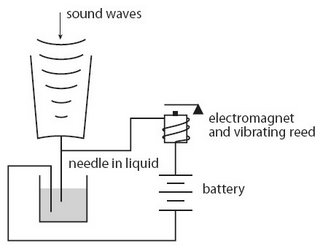The first mic was a glass jar of acid and a wire. It was inconsistent, insensitive and delicate simultaneously and in short; not commercially viable. It was never patented (as a broad concept) to my knowledge, and so of course it appears in most early telephones. This gives the liquid microphone a messy lineage in the hands of various successful, and failed inventors. The liquid microphone was invented in 1906, 1910, 1912 and again as late as 1914.
In 1876, Elisha Gray tried to file a patent for the telephone. His caveat paperwork described a version that used a liquid microphone. Bell beat him out. But of course Bell was using a liquid microphone as well. But in a twist of irony Gray built and patented the version of liquid microphone, that Bell was using! Bell wrote him a letter about it.
Bell's own liquid mic kind of sucked. Bell’s liquid transmitter consisted of a metal cup filled with a mixture of acid and water. A sound wave causes a diaphragm to move thereby forcing the wire connected to it to move up and down in the liquid. The electrical resistance between the wire and the cup is inversely proportional to the amount of wire submerged. A nice description here.
Let me reiterate that this is totally obsolete techology. But... You are reading ARCANE RADIO TRIVIA. You gotta expect this left-field crap. In Italy this next one was a big deal for about 2 or 3 days. Quirino Majorana and Rodolfo Vanni invented one of the earliest working liquid microphones.

It functioned as follows: A reservoir holds a conductive liquid that flows down and out of vessle in a very fine stream. This stream breaks into fine droplets and impacts a diaphragm A set of contacts is located at this point. Sound variations on the diaphragm vary the pressure of the stream. Consequently, the thickness of the stream at the contacts varies, producing a variable resistance in proportion to the sound on the diaphram. This hydraulic microphone/transmitter apparatus successfully broadcast voice messages from Rome to Tripoli, a distance of nearly 1000 Km in 1908. I'd love to tell you more about this but all the articles are in Italian...
The carbon mic was adopted almost instantly as a replacement for the liquid mic. Today liquid mics are occassionaly built by hobbists and weirdo hippies doing home recording. otherwise they are extinct.




No comments:
Post a Comment